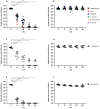Antimicrobial Photodynamic Activity of the Zn(II) Phthalocyanine RLP068/Cl Versus Antimicrobial-Resistant Priority Pathogens
- PMID: 40806672
- PMCID: PMC12347331
- DOI: 10.3390/ijms26157545
Antimicrobial Photodynamic Activity of the Zn(II) Phthalocyanine RLP068/Cl Versus Antimicrobial-Resistant Priority Pathogens
Abstract
The emergence and spread of antimicrobial resistance among pathogens are significantly reducing available therapeutic options, highlighting the urgent need for novel and complementary treatment strategies. Antimicrobial photodynamic therapy (aPDT) is a promising alternative approach that can overcome antimicrobial resistance through a multitarget mechanism of action, exerting direct bactericidal and fungicidal effects with minimal risk of resistance development. Although aPDT has shown efficacy against a variety of pathogens, data on its activity against large collections of clinical multidrug-resistant strains are still limited. In this study, we assessed the antimicrobial activity of the photosensitizer RLP068/Cl combined with a red light-emitting LED source at 630 nm (Molteni Farmaceutici, Italy) against a large panel of Gram-negative and Gram-positive bacterial strains harboring relevant resistance traits and Candida species. Our results demonstrated the significant microbicidal activity of RLP068/Cl against all of the tested strains regardless of their resistance phenotype, with particularly prominent activity against Gram-positive bacteria (range of bactericidal concentrations 0.05-0.1 µM), which required significantly lower exposure to photosensitizer compared to Candida and Gram-negative species (range 5-20 µM). Overall, these findings support the potential use of RLP068/Cl-mediated aPDT as an effective therapeutic strategy for the management of localized infections caused by MDR organisms, particularly when conventional therapeutic options are limited.
Keywords: Zn(II) phthalocyanine; multidrug-resistant pathogens; photoinactivation.
Conflict of interest statement
The sponsors had no role in the design of the study and in the execution, analyses and interpretation of data. Author Francesco Giuliani (Molteni Farmaceutici) contributed exclusively to the revision and final editing of the manuscript.
Figures



Similar articles
-
Prescription of Controlled Substances: Benefits and Risks.2025 Jul 6. In: StatPearls [Internet]. Treasure Island (FL): StatPearls Publishing; 2025 Jan–. 2025 Jul 6. In: StatPearls [Internet]. Treasure Island (FL): StatPearls Publishing; 2025 Jan–. PMID: 30726003 Free Books & Documents.
-
In vitro resistance selection studies of RLP068/Cl, a new Zn(II) phthalocyanine suitable for antimicrobial photodynamic therapy.Antimicrob Agents Chemother. 2010 Feb;54(2):637-42. doi: 10.1128/AAC.00603-09. Epub 2009 Dec 14. Antimicrob Agents Chemother. 2010. PMID: 20008782 Free PMC article.
-
A systematic review on natural products with antimicrobial potential against WHO's priority pathogens.Eur J Med Res. 2025 Jul 1;30(1):525. doi: 10.1186/s40001-025-02717-x. Eur J Med Res. 2025. PMID: 40597250 Free PMC article.
-
2D and 3D in vitro photodynamic activities of tetra-substituted symmetric water-soluble cationic zinc(II) phthalocyanines on cancer.Sci Rep. 2025 Jul 11;15(1):25148. doi: 10.1038/s41598-025-09630-7. Sci Rep. 2025. PMID: 40646060 Free PMC article.
-
Effect of selective decontamination on antimicrobial resistance in intensive care units: a systematic review and meta-analysis.Lancet Infect Dis. 2013 Apr;13(4):328-41. doi: 10.1016/S1473-3099(12)70322-5. Epub 2013 Jan 25. Lancet Infect Dis. 2013. PMID: 23352693
References
MeSH terms
Substances
Grants and funding
LinkOut - more resources
Full Text Sources
Medical

